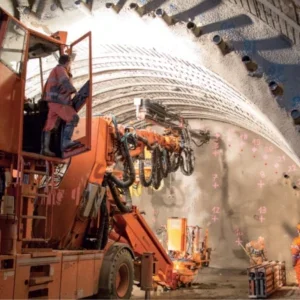This recent publication has brought together some 40 years of research into the engineering behaviour of chalk and represents a conclusion of many seminal publications and events in which chalk has been discussed and in particular many of the topics covered at the Brighton Chalk Conference of 1989. The authors, who are recognised authorities on chalk, have managed to bring together the significant issues whilst discarding those theories, which over the course of time have been superseded.
Chapters 1-4 describe the geology and engineering geology of chalk and a review of many typical engineering properties. The description and classification system originally presented in PR11 is enhanced and made more suitable for field assessments. This book clearly recognises the importance of correct lithostratigraphic identification and the consequential variations in chalk behaviour. Numerous clear photographs of various grades of chalk are included in the chapter on classification, which are definite aids.
The next four chapters develop practices for the engineering in: chalk to earthworks; cuttings, retaining structures and anchorages; shallow foundations; and piled foundations. It is these chapters that bring together the years of research, design and construction in chalk into a well-presented and useful document. Guidance for design is clear and the basis for the various methods are well demonstrated.
The earthworks section is particularly thorough. The ‘method’ and end product specifications for earthworks, based on recent work on the CTRL, is presented with a series of recommendations to make best use of this valuable material.
Much of the piling section develops from PR11 and many of the problems found within it have been resolved. For example skin friction for bearing pile design is now related to effective stress and SPT ‘N’ values for base capacity. The use of effective stress for shaft friction overcomes the inconsistencies with SPT ‘N’ values particularly where flints are found within the chalk. There is a specific section on the design of CFA piles, which pulls together work currently ongoing between CIRIA and the FPS.
The final chapter presents information on site investigations in chalk. Geotechnical hazards particular to chalk are listed, followed by a commentary on investigation procedures. It does however highlight particular aspects relating to chalk especially the need to recover high quality core samples and some of the deficiencies of the SPT.
The major gap in the study, however, is the consideration of tunnels in chalk and this is admitted to in the book’s introduction. Tunnels, it says, is a specialised subject in its own right, although many of the subjects covered in the book are entirely relevant to tunnelling.
In conclusion, it is a major benefit having all of the latest information on chalk contained within one volume and is recommended to all practitioners. It is easy to read, well set out, and will no doubt become the key reference to construction in chalk for many years to come.
Engineering in Chalk (C574) is priced at US$88 to CIRIA Core and New Books Club members and US$177 to others: web site: www.ciria.org.uk; fax: +44 20 7222 1708
Review by R J Margerison and J M Pennington, AMEC






